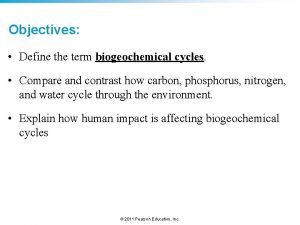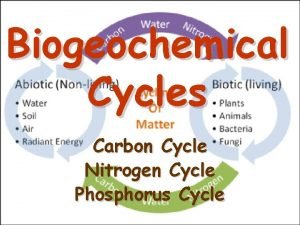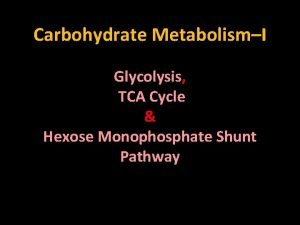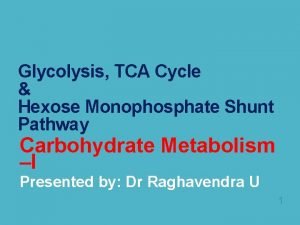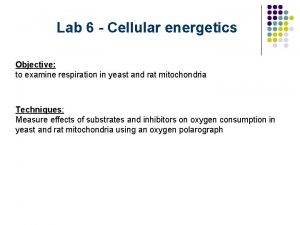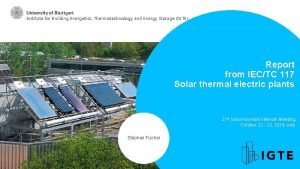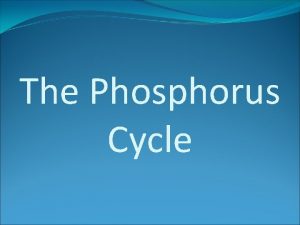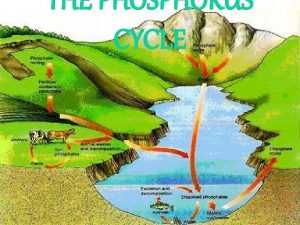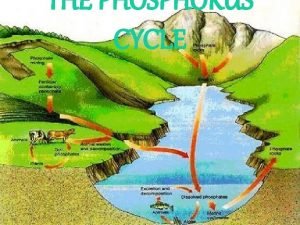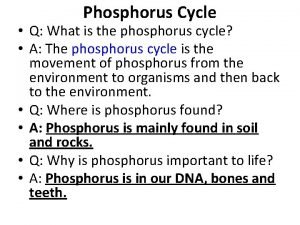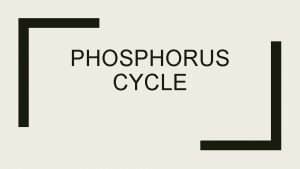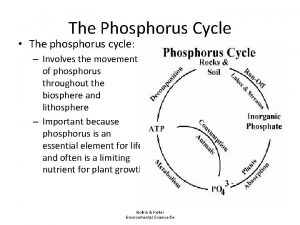Phosphorus Cycle Phosphorus is essential to the energetics







- Slides: 7

Phosphorus Cycle • Phosphorus is essential to the energetics, genetics and structure of living systems. Phosphorus forms part of the ATP, RNA, DNA and phospholipid molecules. • The phosphorus cycle is crucial because phosphorus is usually the limiting nutrient in ecosystem. In contrast to C and N, there are no common stable gaseous forms of phosphorus, so the phosphorus cycle is endogenic. [endogenic cycles: predominantly involve subsurface rocks of various kind. Exogenic cycles: occur largely on Earth’s surface and usually have an atmospheric component] • The main reservoirs of phosphorus are rock, natural phosphate deposits and marine sediments. Phosphorus is release from the rocks and minerals by weathering, leaching, erosion, and mining for use as agricultural fertilizers.

• Soil may contain substantial quantities of phosphorus. However, much of the phosphorus in soils occurs in chemical forms not directly available to plants. • Phosphorus, like nitrogen, must be present in a simple inorganic form before it can be taken up by plants. • Phosphorus is slowly released to terrestrial and aquatic ecosystems through the weathering of rocks. As phosphorus is released from mineral deposits, it is absorbed by plants and recycled within ecosystems. • The phosphates (inorganic phosphates, mainly orthophosphate ions; PO 43 -, HPO 42 -, H 2 PO 4 -, H 3 PO 4) are utilized by plants in metabolism and then passed on to heterotrophic organism through food chain. The decomposition of organic matter of plant and animal by microorganisms releases the phosphates in the soil and makes them available to plants once again.

• Soluble phosphorus from phosphate minerals and other sources such as fertilizers is taken up by plants and incorporated into nucleic acids, which make up the genetic material of organisms. • In the p. H range that is present in most soils, H 2 PO 4 - and HPO 42 - are the predominant orthophosphate species. • Orthophosphate is most available to plants at p. H values near neutrality. In relatively acidic soil, orthophosphate ions precipitated or sorbed by species of Al(III) and Fe(III). In alkaline soils, orthophosphate may react with calcium carbonate to form relatively insoluble hydroxyapatite: 3 HPO 42 - + 5 Ca. CO 3 + 2 H 2 O Ca 5(PO 4)3(OH) + 5 HCO 3 - + OH-

• In marine and freshwater ecosystem, the phosphorus cycle has 3 states: - particulate organic phosphates, dissolved organic phosphates and inorganic phosphates. • Organic phosphates are taken up quickly by all forms of phytoplankton, which are eaten in turn by zooplankton and detritusfeeding organisms. • Zooplankton excretes as much phosphorus (more than half is inorganic phosphate) daily as it stores in its biomass, returning it to the cycle. The inorganic phosphate is taken up by phytoplankton. • The phosphorus in aquatic ecosystem in organic compounds is utilized by bacteria, which fail to regenerate much dissolved inorganic phosphates. Bacteria are consumed by the microbial grazers, which then excrete the phosphate they digest. Part of phosphate is deposited in shallow sediments and in deep water.

• In recent years the excessive use of phosphate fertilizers to increase primary production, and the use of detergents in household and elsewhere, has created pollution problems and the loss of phosphorus to oceans and other fresh water bodies. This is also one cause of the eutrophication of fresh water bodies. • The global phosphorus cycle is unique among the major biogeochemical cycles in having no significant atmospheric components, However, it may be found in air as tiny solid particles.

The Phosphorus Cycle: Soluble inorganic phosphate, As HPO 42 -, H 2 PO 4 -, and polyphosohates Assimilation by organisms Biodegradation Fertilizer runoff, wastewater, detergent wastes Xenobiotic organophosphates Biological phosphorus, predominantly nucleic acids, ADP, ATP Precipitation Dissolution Insoluble inorganic phosphate, Such as Ca 5(OH)(PO 4)3 or iron phosphate Biological organic and inorganic phosphates in sediments

The phosphorus cycle in aquatic and terrestrial ecosystems
